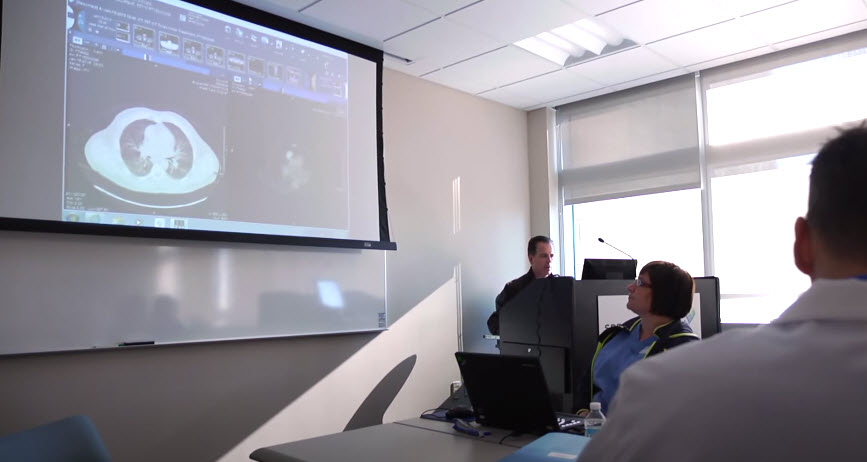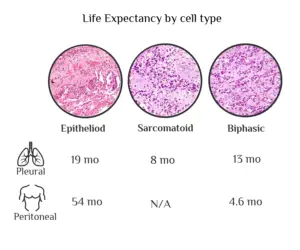Peritoneal Mesothelioma Survival Rate
Peritoneal Mesothelioma Survival Rate
Peritoneal mesothelioma survival rate average is six months for men and thirteen months for women (Source). A quarter of the patients of peritoneal mesothelioma have a survival rate of 3 years after being diagnosed with the condition (Source). For this survival rate calculation (Source), the long term and the short term survival rates have been averaged out.
In the rest of the article, we will explain what is the life expectancy and the survival rate and how this peritoneal mesothelioma survival rate should be analyzed (Source) and compared (Source).
Life Expectancy And Peritoneal Mesothelioma Survival Rate
In medicine, the prognosis is shaped by a number of different variables and making it, especially in cases of aggressive and deadly diseases such as peritoneal mesothelioma is a challenging task for specialists. There are two statistical measures that influence the prognosis of a disease. Those are life expectancy and survival rate.
Let´s go through life expectancy and survival rate of peritoneal mesothelioma more in detail.

Life Expectancy And Factors That Affect It
Life expectancy is a statistical measure that shows how long an organism is expected to live in given circumstances. Life expectancy is influenced by different variables- gender, age, genetics, environment, etc. In medicine, depending on the condition, it is expressed as a number of days, weeks, months or years, a patient is expected to live from a certain point in time (in case of mesothelioma, from the moment of diagnosis).
Staging And Life Expectancy In Peritoneal Mesothelioma Survival Rate Calculations
Prognosis depends almost entirely on the stage of the disease at the time of diagnosis. Essentially, staging is based on the categorization of mesothelioma according to how much it spread. Staging is a common step in diagnosing all malignancies and staging systems differ depending on the type and location of cancer.
For mesothelioma, the system of four stages (stage 1-4) is used to describe the extent of cancer within the body. Stage 1 has the best prognosis, while stage 4 is used for terminal disease (palliative care).
Once determined, the stage of cancer does not change as the disease progresses or recedes. The classification is performed only once, at the time of diagnosis. Stages help doctors choose the treatment program, to begin with, but later on, progression or regression of a disease determines the actual treatment.
Staging is done after numerous diagnostic tests have been performed (imaging techniques, laboratory findings, and physical examination).
Having in mind how rare the mesothelioma is, only pleural mesothelioma has detailed guidelines for staging, while other types (peritoneal and pericardial) are classified based on the American Joint Committee on Cancer (AJCC) general guidelines.
Stage 1
The cancer is in one location, there is no detectable spreading to lymph nodes, other organs or tissues. Surgery is the treatment method of choice in such cases.
Stage 2
Cancer has spread on the surrounding organs and tissues, lymph nodes may be involved as well. In such cases, surgical resection is the treatment method of choice, but the success depends on the extent of the growth.
Stage 3
Cancer has invaded surrounding tissues and entire anatomical region, infiltrates structures like chest wall, regional lymph nodes, esophagus, etc. In cases like this surgery is not an option (in terms of curative treatment, palliative interventions may be an option, depending on the symptoms). Other treatment modalities may be tried.
Stage 4
Cancer has spread to distant organs and regions across the body. The treatment goal in this stage is to reduce discomfort and pain. Rarely, palliative surgical intervention may be carried out.
Peritoneal Mesothelioma Staging
Since the Pleural mesothelioma is the most common type, different systems for its staging has been developed over years, and applicable, mutatis mutandi, for establishing peritoneal mesothelioma survival rate. The most important are:
– Butchart Staging System
– TNM Classification
– Brigham Staging System
Each of these has its advantages and disadvantages. Each patient diagnosed with Pleural mesothelioma goes through all of these classifications.
Staging systems provide guidance about prognosis. Each patient reacts differently to the treatment, so sometimes those classified as stage 2 outlive patients with stage 1 mesothelioma. The point is- no matter the stage, there’s always hope!
The chart below shows the relation between the life expectancy and stage of a mesothelioma. The higher the stage, the shorter is the life expectancy. Keep in mind that this might not be the case in every single mesothelioma patient. As mentioned above, sometimes those with higher stage outlive those with lower stage mesothelioma.

Peritoneal Mesothelioma Survival Rate: Location and Life Expectancy
Pleural mesothelioma has a better prognosis than peritoneal mesothelioma, while pericardial mesothelioma is quite often diagnosed not before an autopsy. Over the past 10 years, the treatment and prognosis for peritoneal mesothelioma have improved significantly.
Age At Diagnosis vs Life Expectancy
In general, older patients have a shorter life expectancy. The explanation lies in the fact that older population often has comorbidities that interfere with the treatment.

Gender vs Life Expectancy And Incidence
Women diagnosed with malignant mesothelioma live, on average, 5.5 months longer than men. While the reason for the longer life expectancy in women remains to be unexplained, the lower incidence of malignant mesothelioma in women is explained by occupational differences.
Cell Type And Life Expectancy
Epitheloid mesothelioma has the best prognosis compared to other two types. Sarcomatoid mesothelioma has the worst prognosis. The biphasic type consists of both populations of cells. The prognosis varies on the number of sarcomatoid cells- the more, the worse.
Other Factors And Life Expectancy
Factors that correlate with a better prognosis are non-smokers (and no history of smoking), normal white blood cell count at the time of diagnosis, low platelet count, low hemoglobin level, asymptomatic.
On the other hand, the prognosis is poorer in those who are smokers (or have been smokers at some point of their lives), have elevated white blood cell count, have high platelet and/or hemoglobin count and report symptoms.
Survival Rate And Factors That Affect It
While the life expectancy is a period of time a person is expected to live, the survival rate is a median percentage of patients who live a certain amount of time. Typically, the 5-year survival rate is a standard statistic category in cancer treatment and prognosis research, but having in mind how aggressive and deadly malignant mesothelioma is, shorter periods of time are used as statistical categories as well.
Survival Rates Depending On The Mesothelioma Type
Not all types of mesothelioma have the same survival rate. In general, peritoneal mesothelioma has the best survival rates, pleural falls behind (mostly due to very long latency period), and pericardial has the worse survival rates (also it’s the rarest form).
The data stated in the chart below shows cumulative survival rates for mesothelioma for both genders. Each of those is affected by other factors such as age, gender, cell type, location, overall health and other factors that have been discussed in the article.
Besides the above mentioned, cumulative statistics, the more detailed chart below describes the survival rate by localization.
The peritoneal mesothelioma has the best survival rate compared to the other two:
Survival Rates vs Treatment
In general, the more treatment modalities are applied, the higher are the survival rates. Patients who undergo surgery (which has a goal of reducing the number of cancer cells in the body) and then undergo chemotherapy (in case of pleural mesothelioma) or CRS-207 + Hyperthermic Intraperitoneal Chemotherapy (HIPEC) (in case of peritoneal mesothelioma) have higher survival rates than those who do not undergo surgery and receive chemo alone.
This is explained by the fact that surgery is indicated in lower stage mesothelioma (stages 1 and 2)- they have better chances from the first day of the treatment. Also, the effects of reducing the number of cancerous cells should not be underestimated either.
Pleural mesothelioma survival rate by treatment type
Chemotherapy alone 2-year survival rate is roughly 20%, while those who undergo surgery and then chemotherapy as an adjuvant therapy have a survival rate of approximately 40%. The 5-year survival rates are 4% and 11% respectively.
Peritoneal mesothelioma survival rate by treatment type
The patients who undergo cytoreductive surgery combined with HIPEC have a 5-year survival rate of 50%, while those who receive chemotherapy as adjuvant treatment achieve a 5-year survival rate of approximately 67%.
Peritoneal Mesothelioma Survival Rate: Conclusion
The prognosis of mesothelioma is a very complex estimation that depends on many different factors. Based on the facts stated above, it is obvious there is no simple formula that can just calculate the patient’s chances to survive the next one or two years nor to provide an accurate estimation on how much time the patient has at his hands.
Also, mesothelioma life expectancy and survival rates have improved dramatically in the past 20 years and as new treatment modalities arise, the chances are, the trend of improvement will continue in the coming years.
Mesothelioma is a form of cancer that affects mesothelium- a thin lining of the internal organs. It is rare cancer, caused by long-term exposure to asbestos. The benign form is even rarer and we know almost nothing about it- its causes are unknown. Just like in case of other malignancies- the timely established diagnosis improves patient’s life expectancy and chances for recovery. Mesothelioma, in general, has a poor prognosis. The reason for such a poor prognosis lies in a fact that mesothelioma remains „silent“ for a long time (long latency period) and often, at the time the first symptoms emerge, the disease has already advanced to its terminal stage.
The bottom line is that 90% percent of people diagnosed with some kind of mesothelioma die within five years. Most live between 6 and 24 months and just a fraction survive it.





